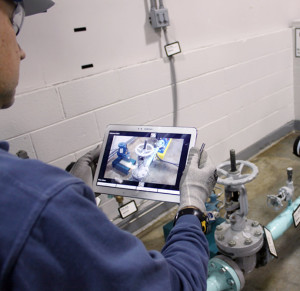
A Promising New Way to Reduce Radiation Exposure to Nuclear Workers
EPRI is developing a prototype system using tablet computers equipped with camera or video connected to databases to verify the open-or-closed status of a valve or switch in a nuclear power plant. Testing began last June at the Tennessee Valley Authority’s Bellefonte Nuclear Generating Station, and a second testing phase is in progress. If successful, the device will perform vital verification tasks now done by humans—saving time, reducing human error and radiation dose, and improving plant reliability.
Independent Verification in the Hands of Machines
Since the dawn of the nuclear power industry, plant workers have been tasked with double-checking the work of their colleagues. In a typical scenario, when a worker opens or closes a valve, an independent verifier follows and rechecks everything, ensuring that the first worker didn’t make any mistakes. With roots in the U.S. nuclear navy, such independent verification has long been a core tenet of the industry’s safety culture.
There are potential downsides to human verification. Every check pulls a worker away from another job, with possible radiation exposure. People are prone to attention lapses, particularly during repetitive verification tasks, and may be reluctant to question a trusted colleague’s work.
But what if a handheld tablet computer could do the work of a human verifier? To investigate this question, EPRI developed a prototype. Here’s how it works. The user performs a procedure—such as closing a valve—and at each step photographs the component with the tablet’s digital camera. The tablet’s software compares each photograph with a laser-scanned three-dimensional model of the component, recording and detecting whether the component is open or closed. As the software determines that a given step in the procedure is completed, it allows the user to move to the next step.
Embedded in the procedure is a fully independent verification that both avoids the need to dispatch a second person later and catches rare-but-inevitable human errors for better reliability. Because the procedure is driven by tablet software, no paperwork is required.
At the Bellefonte station, researchers tested procedures on gate valves, butterfly valves, lighting panel switches, and motor control center breakers. In each procedure, the prototype accurately verified the component’s status.
Refining the Verifier
EPRI is conducting a second test phase at Duke Energy’s Catawba Nuclear Station in 2015 to investigate the use of video. The verifier moves the tablet’s video camera 360 degrees around a component and processes the video into a three-dimensional representation of the component. The software compares this image with the reference model to determine the component’s open or closed status.
Also, researchers plan to make the system fully portable and self-contained, eliminating the need to be docked to a separate laptop to run the verification software. They want to investigate the economic feasibility of building a digital library of three-dimensional reference shapes of thousands of plant components potentially requiring verification.
If a workable device is commercialized, human verifiers will be among the key beneficiaries. “We respect radiation,” said David Ziebell, EPRI senior technical leader. “If we send somebody out to containment to do a valve alignment, that person’s going to absorb dose. If we send a second person out to verify, that person’s also going to absorb dose. If we can reduce that, that’s a win for all involved.”
EPRI Technical Expert:
David Ziebell


